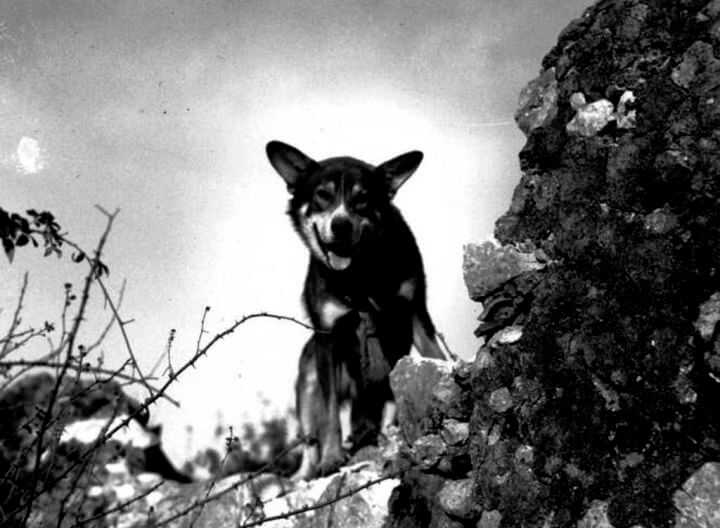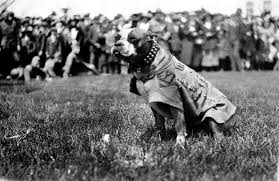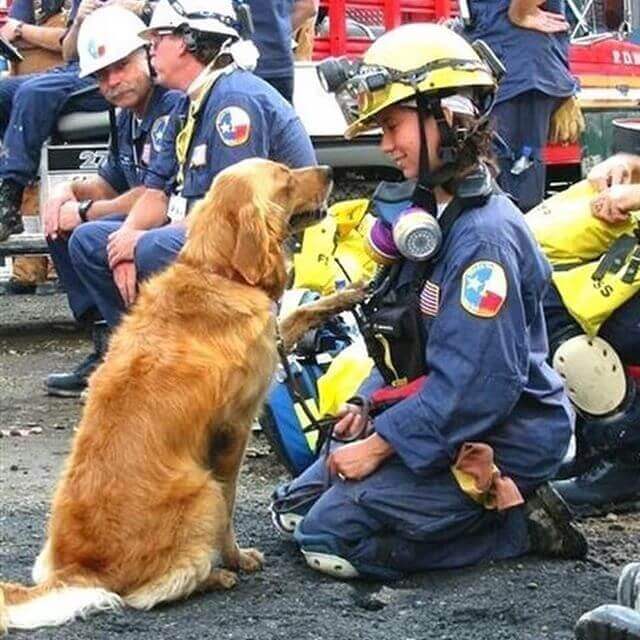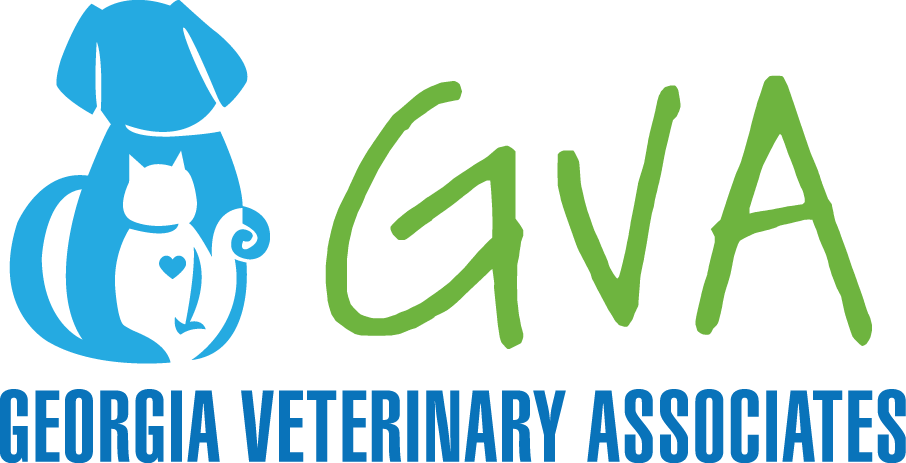March 13th is National K9 Veterans Day. A day set aside to honor those who have served and scarified for their country throughout history. The day marks the 77th anniversary of the Army War Dog Program dubbed the "K-9 Corps" and marks the first time dogs were officially part of the U.S Armed Forces. In honor of all those who have served, here's a brief article on the history of dogs in the public sector and a few exceptional examples of how intergal dogs are to public safety.
War Dogs:
During WWI over a million dogs were used on both sides as messengers and mental health support to the soldiers deep within the trenches of the war. Among all those who served, one dog emerged as a K9 icon; Rin Tin Tin. This German Shepherd was rescued by an American solider, Lee Duncan and became a huge hit in silent films through out the United states. The rise in Rin Tin Tin's popularity made the German Shepherd a more iconic family dog and the popularity of the breed increased.
After WWI very few dogs were still being used or even trained for that matter. When WWII began, the American Kennel Club and a small group known as the Dogs for Defense began a call to action asking all pet owners to donate any healthy and capable dogs to the U.S Army. These dogs would begin an 8 to 12 week course that would station them in either the Army, Marines, or the Coast Guard for jobs such as sentry dogs, scout dogs, messenger dogs, or mine-detection dogs.
After an influx of donations, the U.S Army restricted the breed to what we commonly know as working dogs today such as German Shepherds, Belgian Malinois, Doberman Pinschers, Border Collies, Siberian Huskies, Alaskan Malamutes, and Eskimo Dogs.
Famous War Dogs:
 Chips was a Collie Shepherd mix who became the most decorated dog in WWII. Chips became a world traveler and was stationed in locations such as Germany, France, North Africa, and Sicily. He became a decorated war hero after he took down a machine gun nest in Italy and helped to take over 10 Italian solders captive after an attack. These achievements awarded him the Distinguished Service Cross, the Purple Heart, and the Silver Star. Unfortunately, the medals were taken away as military policy at the time didn't allow for animals to be recognized in such a manner. Chips survived the war and made it home to New York in 1945. (Pictured Right, Chips in the field during WWII)
Chips was a Collie Shepherd mix who became the most decorated dog in WWII. Chips became a world traveler and was stationed in locations such as Germany, France, North Africa, and Sicily. He became a decorated war hero after he took down a machine gun nest in Italy and helped to take over 10 Italian solders captive after an attack. These achievements awarded him the Distinguished Service Cross, the Purple Heart, and the Silver Star. Unfortunately, the medals were taken away as military policy at the time didn't allow for animals to be recognized in such a manner. Chips survived the war and made it home to New York in 1945. (Pictured Right, Chips in the field during WWII)
Kaiser was a German Shepherd who served in the Vietnam war. He served in more then 30 combat missions and was an instrumental tool in over 12 major operations along with his handler Marine Lance Cpl. Alfredo Salazer. Unfortunately, Kaiser didn't make it home and passed away in an ambush by an enemy patrol in 1966. Kaiser became the first war dog killed in action in Vietnam.
Nemo, another German Shepherd was stationed in Vietnam. While on patrol with his handler Airmen 2nd Class Bob Thorneburg, they found themselves under fire. While Nemo took a round to the eye and Thorneburg a hit to his shoulder, Nemo continued to protect his handler which give him enough time to call in reinforcements. Nemo was so protective of his unconscious handler it took a few people to remove Nemo and treat both his wounds and Thorneburg's. Both recovered after the attack and because of his service Nemo was permanently retired. He passed away in 1972 at the age of 11.
Smokey wasn't your average war dog. He was a Yorkshire Terrier that was found in an abandoned trench in the jungles of New Guinea in 1944. He used his sharp sense of hearing and smell to help warn soldiers of incoming air raids and survived upwards of 150 of them. On top of that, because of his small size, he was able to help connect telegraph wires thorough small pipes. This helped keep troops stay safe and saved time that would have been spent digging up and laying the wire by hand. Smokey died at the age of 14 in 1957. His war time antics can be read about in the book titled Yorkie Doodle Dandy written by his adoptive owner.

Stubby was an American Pitt Bull Terrier and was the only dog to ever have been given the rank of Sergeant. Stubby was a stray found in 1917 that was smuggled to France by his owner, Cpl. John Robert Conroy. He was involved in 17 battles during WWI and was a huge moral boost for the troops. He, like Smokey, used his sense of smell to warm the soldiers about income gas attacks, air raids, and helped to locate injured soldiers on the battle field. The Stubby Award for Canine Heroism is named after him. Stubby died in 1926 in his owner's arms. (Pictured Right, Stubby WWI decorated Sergeant)
In more recent news, Cairo, a Belgian Malinois, was the SEAL working dog instrumental in bringing down Osama bin Laden in the Middle East back in 2011. Cairo was used to help detect bombs, look for hidden enemies, and search for hidden passage ways and rooms. At a small private ceremony honoring those who helped bring down bin Laden, President Obama was unaware that Cairo, a dog, was part of the mission. When he found out, all President Obama wanted to do was meet the pooch who was waiting in an adjacent room. Cairo was awarded Time's Animal of the Year in 2011.
Police Dogs:
Dating even further back that military dogs, police have officially been using the K9 for over 100 years. Use of dogs for tracking down people and aiding in police work has been dated back to almost 14th century France, but no official records have been kept. One of the earliest known uses of dogs in the police field was back in 1888. The English used blood hounds while searching for the notorious Jack the Ripper, a test that ultimately back fired as the dogs ended up biting the commissioner and running off, promoting a search for said blood hounds. It wasn't until 1899 that Belgium began training dogs specifically for police work. This started the rise in popularity in working police dogs across Europe. Even later then Europe, in 1977 the U.S began to take note and implemented Police Dogs across the country.
Mattie was a Black Labrador Retriever who worked for the Connecticut State Police as an arson dog. She was able to dig through the charred remains and find small traces of accelerant such as gasoline. In 1986, Mattie became the first Operational Accelerant Detection Dog in the country.
Search and Rescue Dogs:
Even further back then Military and Police dogs, St. Bernards have been used as search and recuse dogs as far back as the 17th century. Introduced to the mountainous Monastery near the Great St Bernard Pass, these dogs were originally used as guard dogs. Once the monks, who had already been preforming search and recuse missions without the dogs, discovered the St. Bernards keen sense of direction they became an instrumental tool in locating lost travelers in bad weather. It wasn't until WWI that the red cross adapted this behavior and began training Collies to find wounded soldiers in the battle field during lull times. Brought back in WWII, London used search and rescue dogs to find survivors trapped in burning buildings after the 1941 bombings.
In more recent events, search and recuse dogs helped find survivors within the turmoil of 9/11. Over 300 dogs were used in the aftermath of 9/11.
 Bretagne, pronounced Brit-nee, was 2 years old at the time of the 9/11 attacks. She and her handler were on site for over 10 days where their mission went from search and rescue to recovery. At 8 weeks old, Bretagne began training and her and her handler were soon pronounced a FEMA-certified team. On top of working in 9/11, they were dispatched to hurricane rescue missions for Katrina, Rita, and Ivan. While Bretagne retired at the age of 6, she was used to help promote her local fire department and was often found visiting local elementary schools. She soon became the only living search and recuse dog who worked on 9/11 and remained so up until she passed away in 2016 at the old age of 17. She was honored in her death with a line of fire fighters and fellow rescue dogs as she was carried out of the vet hospital, her body covered in an American flag. (Pictured Left, Bretagne with her handler Denise Corliss)
Bretagne, pronounced Brit-nee, was 2 years old at the time of the 9/11 attacks. She and her handler were on site for over 10 days where their mission went from search and rescue to recovery. At 8 weeks old, Bretagne began training and her and her handler were soon pronounced a FEMA-certified team. On top of working in 9/11, they were dispatched to hurricane rescue missions for Katrina, Rita, and Ivan. While Bretagne retired at the age of 6, she was used to help promote her local fire department and was often found visiting local elementary schools. She soon became the only living search and recuse dog who worked on 9/11 and remained so up until she passed away in 2016 at the old age of 17. She was honored in her death with a line of fire fighters and fellow rescue dogs as she was carried out of the vet hospital, her body covered in an American flag. (Pictured Left, Bretagne with her handler Denise Corliss)
In short, there are so many brave heroes, both human and K9, that have given their life for the sake of our country. National K9 Veteran's Day is just another day we can use to honor those brave souls.
Russell Ridge ~ Hamilton Ridge ~ Apalachee Ridge ~ Georgia Veterinary Associates
